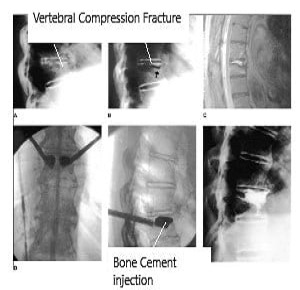Osteoporotic Vertebral Compression Fractures
Osteoporosis means increased spaces within the bone. It is caused by loss of protein matrix as well as the calcium from the bones. It leads to the weakness of the bone. It is a silent killer of the bone and worsens over age.
Females are more commonly affected, especially in the postmenopausal period, than men. 50% of females and 25% of males above 50 years of age have decreased bone density. Patients with osteoporosis are at higher risk of fragility fractures. These fractures include fracture of the distal end of the radius of the wrist and vertebral fractures.

Intraoperative fluoroscopic images showing Kyphoplasty.
A vertebral compression fracture happens in the mid and lower back area. In most instances, there is no inciting factor, and these are incidental findings. Occasionally, patients may have a fall. Patients who have such fractures are mostly treated conservatively, bed rest, pain medication, and bracing along with supplementation of calcium and vitamin D as needed. Patients who have low vitamin D levels need a high dose of vitamin D.
Patients with chronic disease, as well as patients who are on long-term steroids, are at high risk of osteoporosis. These patients should be screened regularly. Appropriately, patients should be treated to decrease bone mass loss and increase their bone density.
Patients with osteoporotic vertebral fractures do well most of the time and have relief from pain in 3 to 6 weeks. They can ambulate with or without a brace. Patients who are not able to get better are advised vertebroplasty or kyphoplasty. Vertebroplasty involves filling up the vertebra with bone cement. Kyphoplasty is a modification of vertebroplasty in which a balloon is inflated inside the vertebrae to restore the height of the vertebra. Then the cavities are filled with bone cement.
Osteoporosis Indications
Patients who have multiple compression fractures had no relief with conservative measures. Occasionally patients with malignancy like metastases or multiple myeloma of the vertebral body with pain can be a candidate for vertebroplasty or kyphoplasty.
Osteoporosis Contraindications
Patients who have multiple vertebral involvements, severe osteoporosis, vertebral segment instability, and neurological deficits are contraindications for this procedure.
Osteoporosis Procedure
Appropriately chosen patients are worked up by the use of x-ray and MRI. Occasionally, CT scan may be needed. Patients who need vertebroplasty or kyphoplasty are taken to the operating room. The procedure is usually done under general anesthesia but can also be performed under local anesthesia.
Patients are placed prone on the operating table. Intraoperative x-rays or fluoroscopy is used. The procedure is performed through a pinpoint incision through which a hollow needle is passed from the skin into the vertebral body. The location is checked under x-ray imaging.
Once the needle is in the right phase, the vertebra is filled with bone cement if only vertebroplasty is performed. In contrast, for kyphoplasty, a balloon is inflated within the vertebral body to restore the height of the vertebra. Then, bone cement is injected to fill the cavity. The needle is removed before the bone cement hardens.
Once the procedure is over, the patient is flipped onto the back and sent to a recovery room. Most patients are discharged from recovery. Patients are allowed to walk with or without the use of brace after the procedure. Patients are also given some pain medications and are followed in the office.
Risks And Complications
There is a risk of injury to the nerve root or the spinal cord by the needle itself. Occasionally, the bone cement may extravasate out of the vertebral body. If the bone cement extravasates into the spinal canal, it may cause compression of the spinal cord or nerve root and may need urgent decompression surgery to relieve the pressure. It may also rarely lead to neurological deficits. The presence of cement in a vertebra predisposes adjacent vertebrae to fracture is the setting of osteoporosis.
Results And Prognosis
In appropriately chosen patients, vertebroplasty and kyphoplasty are big procedures which are done essentially for pain relief. They can also help restore vertebral height. They gave adequate pain relief in patients with metastasis or multiple myeloma. Vertebroplasty and kyphoplasty help in decreasing pain, improving quality of life, and decreasing mortality. Vertebroplasty can also be used in patients with pain due to hemangioma of the vertebrae.

Dr. Vedant Vaksha
I am Vedant Vaksha, Fellowship trained Spine, Sports and Arthroscopic Surgeon at Complete Orthopedics. I take care of patients with ailments of the neck, back, shoulder, knee, elbow and ankle. I personally approve this content and have written most of it myself.
Please take a look at my profile page and don't hesitate to come in and talk.
